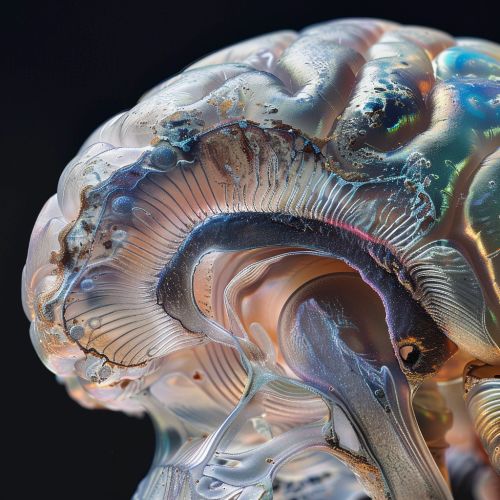Archicortex
Introduction
The archicortex, also known as the archipallium, is a part of the brain's cerebral cortex. It is considered one of the oldest regions in terms of evolutionary development. The archicortex is primarily involved in the formation and consolidation of memories, particularly those related to spatial navigation and emotional responses. This article delves into the anatomical structure, functional significance, and evolutionary aspects of the archicortex, as well as its role in various neurological processes.
Anatomical Structure
The archicortex is a component of the hippocampal formation, which also includes the dentate gyrus and the subiculum. It is characterized by a simpler, three-layered structure compared to the six-layered neocortex. The three layers of the archicortex are:
1. **Molecular Layer**: The outermost layer, which contains a dense network of dendrites and axons. 2. **Pyramidal Layer**: The middle layer, populated by pyramidal neurons that play a crucial role in signal transmission. 3. **Polymorphic Layer**: The innermost layer, containing various types of neurons and supporting cells.
The archicortex is primarily located in the medial temporal lobe of the brain, enveloping the hippocampus.

Functional Significance
The archicortex is integral to several key brain functions, particularly those related to memory and spatial navigation. Its primary roles include:
Memory Formation
The archicortex is heavily involved in the consolidation of long-term memories. It receives input from various sensory modalities and integrates this information to form coherent memory traces. The process of memory consolidation involves the transfer of information from the short-term memory to the long-term storage, a function largely attributed to the interactions between the archicortex and the neocortex.
The archicortex, particularly the hippocampus, is crucial for spatial memory and navigation. It helps in the formation of cognitive maps, which are mental representations of the physical environment. These maps enable an organism to navigate through its surroundings efficiently. Place cells within the hippocampus fire in specific locations, providing a neural basis for spatial memory.
Emotional Responses
The archicortex also plays a role in processing emotional responses. It interacts with the amygdala, a brain region involved in emotion regulation, to modulate emotional memories. This interaction is essential for the formation of memories that have emotional significance, such as those related to fear or pleasure.
Evolutionary Perspective
The archicortex is considered one of the most ancient parts of the cerebral cortex. Its evolutionary origins can be traced back to early vertebrates. The simpler three-layered structure of the archicortex is indicative of its primitive nature compared to the more complex six-layered neocortex. The evolutionary development of the archicortex has been crucial for the survival of species, as it supports essential functions like memory and navigation.
Neurological Processes
The archicortex is involved in various neurological processes, including:
Synaptic Plasticity
Synaptic plasticity, the ability of synapses to strengthen or weaken over time, is a fundamental mechanism underlying learning and memory. The archicortex exhibits a high degree of synaptic plasticity, particularly in the form of long-term potentiation (LTP) and long-term depression (LTD). These processes are essential for the encoding and retrieval of memories.
Neurogenesis
The archicortex, specifically the dentate gyrus, is one of the few brain regions where adult neurogenesis occurs. The generation of new neurons in the adult brain contributes to the plasticity and adaptability of the hippocampal formation, supporting functions like learning and memory.
Neurotransmitter Systems
The archicortex is influenced by various neurotransmitter systems, including glutamate, GABA, and acetylcholine. These neurotransmitters modulate the excitability of neurons and play a role in synaptic transmission and plasticity. Dysregulation of these systems can lead to neurological disorders.
Clinical Relevance
The archicortex is implicated in several neurological and psychiatric conditions, including:
Alzheimer's Disease
Alzheimer's disease is characterized by the progressive degeneration of neurons in the hippocampus and surrounding regions, including the archicortex. This degeneration leads to severe memory impairments and cognitive decline. Understanding the role of the archicortex in Alzheimer's disease is crucial for developing therapeutic interventions.
Epilepsy
Temporal lobe epilepsy often involves the hippocampus and archicortex. Abnormal electrical activity in these regions can lead to recurrent seizures. Surgical resection of the affected areas, including parts of the archicortex, is sometimes necessary to control seizures in patients with drug-resistant epilepsy.
Schizophrenia
Alterations in the structure and function of the archicortex have been observed in patients with schizophrenia. These changes may contribute to the cognitive deficits and memory impairments commonly seen in this disorder. Research into the archicortex's role in schizophrenia is ongoing, with the aim of identifying potential targets for treatment.
Research and Future Directions
Ongoing research into the archicortex aims to further elucidate its functions and mechanisms. Advances in neuroimaging techniques, such as functional MRI and diffusion tensor imaging, are providing new insights into the connectivity and activity of the archicortex. Additionally, studies using animal models are helping to uncover the molecular and cellular processes underlying its functions.
Future research directions include:
- Investigating the role of the archicortex in neurodevelopmental disorders. - Exploring the potential for neurogenesis-based therapies for memory impairments. - Developing targeted interventions for conditions like epilepsy and Alzheimer's disease.
